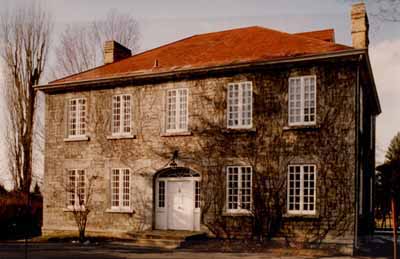Maplelawn & Gardens National Historic Site of Canada
Ottawa, Ontario

Maplelawn residence
© Parks Canada Agency / Agence Parcs Canada, 1980.
Address :
529 Richmond Road, Westboro, Ottawa, Ontario
Recognition Statute:
Historic Sites and Monuments Act (R.S.C., 1985, c. H-4)
Designation Date:
1989-06-22
Dates:
-
1831 to 1834
(Construction)
-
1936 to 1936
(Significant)
Event, Person, Organization:
-
Thomas Cole
(Person)
-
William Thomson
(Person)
Other Name(s):
-
Maplelawn & Gardens
(Designation Name)
-
Thomson-Cole-Rochester House
(Historic Name)
-
Keg Manor
(Other Name)
Research Report Number:
1989-016, 1989-OB-02 Jun
DFRP Number:
56732 00
Plaque(s)
Existing plaque: 529 Richmond Road, Ottawa, Ontario
This elegant residence and its walled garden are a rare and well-preserved example of a country estate in early 19th-century Canada. Built from 1831 to 1834 for William Thomson, a prosperous farmer, its centrepiece is this finely crafted home in the British classical tradition. The oval entrance drive and the walled garden of nearly an acre reflect the original pattern of the grounds. The sheltered environment for growing household vegetables, tender fruit and flowers recalls the walled gardens common in Britain.
Description of Historic Place
Maplelawn & Gardens National Historic Site of Canada is located within a mixed residential and commercial neighbourhood in Ottawa, Ontario. The site comprises a dignified 19th century two-and-a-half-storey stone house and a walled garden. Constructed for William Thomson in the British classical tradition, the house features a five-bay symmetrical façade and a hipped roof flanked by two end chimneys. Official recognition refers to the property boundary of Maplelawn at the time of designation in 1989.
Heritage Value
Maplelawn & Gardens was designated a national historic site of Canada in 1989 because: its gardens are the best preserved of the few known surviving examples of early 19th century walled gardens in Canada. the quality of this finely crafted home in the British classical tradition is exceptional.
Maplelawn & Gardens is a rare and well-preserved example of an early 19th-century country estate in Canada. Constructed in 1831 - 1834 for William Thomson, the residence house is an excellent example of the British classical tradition as exhibited in its rectangular plan, symmetrical façades and its centrally-placed main entrance. The casement windows, however, are not typical of this style and rather reflect French-Canadian building influences on the domestic architecture of the Ottawa Valley. The interior features a wide entrance hall with a Neoclassical semi-elliptical arch at its midpoint. The elegantly curved staircase, paneled doors and ceiling mouldings are typical of houses constructed at this time.
Adjacent to the residence is a rare, one-acre walled garden type also reminiscent of British tradition in Canada. The garden is symmetrical in its layout, and features an oval central bed at the intersection of the two gravel paths, which divide the garden into four lawns. The original stone-crafted wall surrounds both the garden and the house, located in the western section of the enclosure. In its early stages, the garden was used by the Thomson family mainly as a kitchen garden that transitioned into a lush, ornamental perennial garden in the 1940s.
Sources: Historic Sites and Monuments Board of Canada, Minutes, February and June 1989, November 1995.
Character-Defining Elements
Key elements which contribute to the heritage value of the site include: its location within a mixed residential and commercial neighbourhood in Ottawa, Ontario; its setting on a landscaped property, with an oval driveway; surviving elements illustrating the inter-relationship of house and landscape, including the set-back of the house from the main road, the proximity of the walled garden and the house, and the treed nature of the site; its two-and-a-half storey rectangular massing, with a smaller service wing at the rear; its fine ashlar masonry topped by a high hipped roof pierced with dormers and flanked by two chimneys; its five-bay main façade with a centrally-placed main door surrounded by sidelights and a semi-elliptical fanlight; its regularly-spaced multi-paned casement windows reflective of French Canadian craftsmanship; the surviving interior elements that refers to the British classical tradition, including the centre-hall plan with a main stairway at the front and a kitchen/service wing at the rear; the fine craftsmanship and surviving original detailing drawn from classical traditions including the fireplaces and their surroundings; those elements which illustrate the high quality of carpentry and joinery available in the Ottawa Valley in the 19th century, as expressed in the woodwork of the interior arches, baseboards and other mouldings, as well as the decorative plasterwork; those elements which are key to the identity of the walled garden, including the placement and massing of the walls, the surviving original stonework, evidence of the original layout of the garden around a symmetrical structure of gravel paths and the placement of plants in support of the formal design of the garden, and evidence of the original plant choices; those elements of the grounds which support the British classical tradition, namely the naturalistic plantings with the central organizing element as a symmetrical oval driveway connecting the house to the street, approached through paired entrance piers and framing plantings.